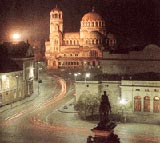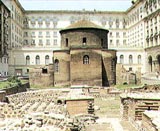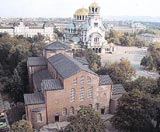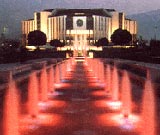保加利亚首都-索非亚
Sofia (Bulgaria)
Sofia, the capital of Bulgaria, has a history that goes back thousands of years. Through the centuries, many peoples have inhabited it and added to its rich and diverse history.Today there are many archaeological sites in Sofia, that display the city's diverse history - the castle gates and towers, public buildings and streets thousands of years old. Many streets, buildings, parks, and even whole neighborhoods preserve the architectural style from the turn of the century.
Between 1879 and 1939, the population of Sofia grew from 20 000 to 300 000, while today 1 250 000 people live in Sofia.
Since ancient times the city was famous for the abudance of cold and thermal mineral water springs in and around it. The water is still available today and is praised for its numerous qualities.
Sofia has the buzz of a capital city and the convenience of a compact center where all the main sights can be visited on foot.
The following are the main points of interest in Sofia:
Alexander Nevski Memorial Church
 Completed in 1912 in honour of the Russian casualties of the 1877-78 War of Liberation from Ottoman Rule. Gold-domed, it is the finest piece of architecture in the Balkans(巴尔干半岛). Craftsmen and artists from 6 countries worked on the five-aisle church in the course of 30 years and created real masterpieces of icons, frescoes, murals and huge chandeliers. The interior decoration, made of Italian marble. Egyptian alabaster(雪花石膏), Brazilian onyx(缟玛瑙), gold, mosaics embodies the spirit of the finest Eastern Orthodox traditions. A superb collection of icons - the best in Bulgaria - can also be seen in the Crypt( 地下室).
Completed in 1912 in honour of the Russian casualties of the 1877-78 War of Liberation from Ottoman Rule. Gold-domed, it is the finest piece of architecture in the Balkans(巴尔干半岛). Craftsmen and artists from 6 countries worked on the five-aisle church in the course of 30 years and created real masterpieces of icons, frescoes, murals and huge chandeliers. The interior decoration, made of Italian marble. Egyptian alabaster(雪花石膏), Brazilian onyx(缟玛瑙), gold, mosaics embodies the spirit of the finest Eastern Orthodox traditions. A superb collection of icons - the best in Bulgaria - can also be seen in the Crypt( 地下室). Rotunda(圆形建筑) of St. George
Rotunda(圆形建筑) of St. George
A C4 brick building in the courtyard behind the Sheraton Hotel, adorned with finely preserved early medieval frescoes. There are also remains of a C2 street and other Byzantine( 拜占庭式的) ruins.
St. Sofia Church
 The 4th-6th century basilica( 长方形基督教堂) was built during the reign of Justinian(东罗马帝国皇帝). It has survived intact with 1600- year-old mosaic details and towards the end of the C14 gave the city its name. Beside the wall of the church is the Tomb of the Unknown Soldier. Nearby is the grave of the national poet and writer Ivan Vazov, marked by an engraved boulder.
The 4th-6th century basilica( 长方形基督教堂) was built during the reign of Justinian(东罗马帝国皇帝). It has survived intact with 1600- year-old mosaic details and towards the end of the C14 gave the city its name. Beside the wall of the church is the Tomb of the Unknown Soldier. Nearby is the grave of the national poet and writer Ivan Vazov, marked by an engraved boulder.

The National Palace Of Culture
The biggest Congress Centre in the Balkans. It is located in the centre of the city and faces the Vitosha Mountain.